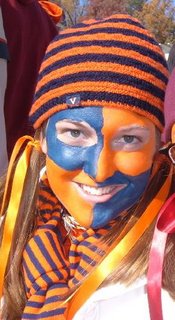Backwards design, Zoho Show...uh oh?
I have a confession...I'm starting to like EDLF 345. It's one of the first classes I have had at UVA where the learning environment is cooperative and the material actually has multiple applications.
Every week, I am learning more. This week is no exception. First of all, I learned valuable information about application of technology in the classroom. Some tips I now know of are testing software programs before implementing them, using kitchen timers for time management, and the cup system (where a student places a cup on his or her monitor if they need help). This week in class we discussed "Backwards Learning" which is a type of lesson planning procedure. In "Backwards Planning," the teacher starts with the objectives she wishes her students to accomplish and then works towards how they can be accomplished. Also, I learned the "10 Commandments of Multimedia Projects." These will be very useful in my academic life as well as my career. Another program, I learned about was Zoho Show. It is basically an online version of Power Point. I definitely feel as though it would be useful in the classroom.
All the topics I learned this week will be extremely useful in the classroom. While I have a class in the computer lab and some students have already finished their assignments, I am going to have prepared my knowledge of educational software games on the computer so that they can have fun while learning. By doing this, all students will be engaged. I think the Zoho Show program will be very useful to set up quick guides, instructions, or examples for classroom use. Also, Zoho Show can be used by students to present projects in an easy to use format. Also, students could work on Zoho Show from home and not have to worry about deliverables or not have Power Point on their computer. Furthermore, by following the 10 Commandments of Multimedia Projects, my classroom use of technology will be more efficient and adequate. Especially the commandment of 'save often and early' will be very beneficial for my students and their work.
One of the questions I have this week is rhetorical, how will I adequately implement technology into the classroom without over doing it?
Here's a fellow classmate's perspective on what is occurring in class...
Until next time...

